过去进行时知识点
英语过去进行时的知识点归纳

英语过去进行时的知识点归纳
一、过去进行时的构成
1、一般过去时:主语+ was/were + 动词的-ing 形式
2、句式:(1)主语+ was/were + 动词-ing
例句:I was working in the garden yesterday afternoon.
(2)主语+ was/were +not+动词-ing
例句:She wasn’t doing anything at that time.
(3)主语+was/were+动词-ing+when/while
例句:He was watching TV when the lights went out.
二、过去进行时的用法
1、表示过去某一时间正在进行的动作
用于已经安排或计划好的将来活动
例句:My friend was taking a shower when I called her.
2、表示过去的某一时刻正在进行的持续性动作
例句:I was studying English at 7 o'clock yesterday.
3、表示过去某时发生的突发事件
例句:My father was reading the newspaper when the phone rang.
4、表示过去某个时间段内,一直在进行的动作
例句:I was doing my homework all afternoon.。
- 1 -。
英语过去进行时时态知识点整理优秀
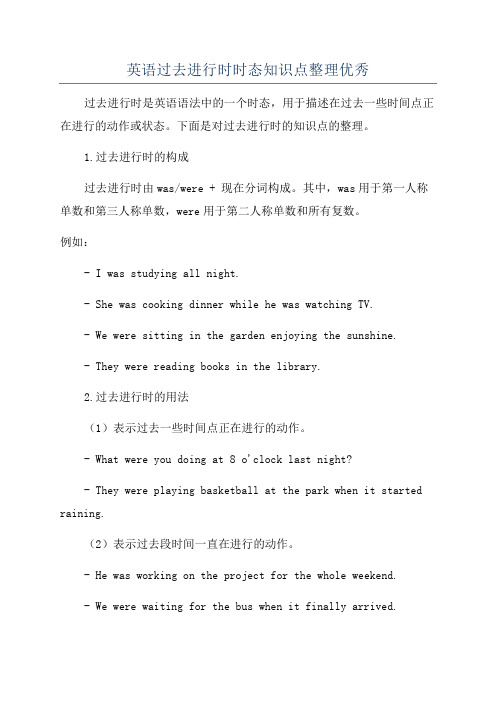
英语过去进行时时态知识点整理优秀过去进行时是英语语法中的一个时态,用于描述在过去一些时间点正在进行的动作或状态。
下面是对过去进行时的知识点的整理。
1.过去进行时的构成过去进行时由was/were + 现在分词构成。
其中,was用于第一人称单数和第三人称单数,were用于第二人称单数和所有复数。
例如:- I was studying all night.- She was cooking dinner while he was watching TV.- We were sitting in the garden enjoying the sunshine.- They were reading books in the library.2.过去进行时的用法(1)表示过去一些时间点正在进行的动作。
- What were you doing at 8 o'clock last night?- They were playing basketball at the park when it started raining.(2)表示过去段时间一直在进行的动作。
- He was working on the project for the whole weekend.- We were waiting for the bus when it finally arrived.(3)表示过去一些时间点由于其他动作的发生而中断的动作。
- I was reading a book when my friend called me.- They were watching a movie when the power went out.(4)与过去一些时间点进行对比,表示过去的同时发生或进展的动作。
- While she was studying, her brother was playing games.- I was walking to work when I saw a car accident.3.过去进行时的否定形式和疑问形式否定形式:在was/were之后加not。
过去进行时知识点总结

过去进行时知识点总结过去进行时是英语中的一种时态,用于描述过去某个时间点或某个时间段内正在进行的动作或状态。
以下是过去进行时的知识点总结:1. 构成:过去进行时的结构是"was/were + 动词的-ing形式",如:"I was studying last night."(我昨晚正在研究。
)2. 使用:a. 过去进行时用于表示过去某个时间点或某个时间段内正在进行的动作或状态。
例如:"She was cooking dinner when I arrived."(我到达时她正在做晚饭。
)b. 过去进行时常与过去的时间状语连用,如:yesterday, last night, at that time等。
例如:"They were playing basketball yesterday afternoon."(昨天下午他们正在打篮球。
)3. 与过去简单时的区别:过去进行时和过去简单时的区别在于过去进行时强调的是正在进行的动作或状态,而过去简单时则强调的是已经完成的动作或状态。
例如:- 过去进行时:"I was reading a book all morning."(整个上午我都在读书。
)- 过去简单时:"I read a book this morning."(今天早上我读了一本书。
)4. 注意事项:a. 过去进行时不用于表示惯性或经常性的动作。
例如,不正确的用法:"He was always playing video games."(他总是在玩电子游戏。
)b. 如果一个动作在过去某个时间点已经完成,并且该动作的结果或影响仍然存在,应该使用过去完成进行时。
例如:"She had been waiting for two hours before the bus arrived."(公交车到达之前,她已经等了两个小时。
七年级过去进行时知识点

七年级过去进行时知识点过去进行时是英语中比较常见的时态之一,在语法上也不算困难,只要掌握好它的构成和用法,就能正确地使用它来表达过去某一时刻正在发生的动作或者事态。
下面,就让我们来一起学习一下七年级的过去进行时知识点吧。
一、构成方式过去进行时是由“was/were+现在分词”构成的,其中was/were 是be动词的过去式,现在分词则是动词的-ing形式。
比如说:- I was watching TV at 8 p.m. last night.- They were playing basketball in the park when it started to rain.二、用法注意事项1. 表示过去某一时刻正在进行的动作过去进行时主要用于描述过去某一时刻正在进行的动作或者事态,常常和过去简单时联用,用于叙述同时或相交的两个或多个动作。
比如说:- She was studying in the library when I called her.- He was cooking dinner while she was reading a book.2. 表示两个过去动作的同时发生过去进行时还可以用于表示两个动作在过去的某个时候同时发生,这时要使用“while”或者“as”来连接两个动作。
比如说:- While she was brushing her teeth, her brother was taking a shower.- As I was walking home, I saw a strange man following me.3. 表示过去某一时刻正在持续的状态过去进行时还可以用于表示过去某一时刻正在进行的状态或者情况,比如说:- The children were being very quiet during the movie.- She was feeling very sad after the breakup.三、易错点解析1. 误用过去简单时有些初学者在使用过去进行时的时候容易和过去简单时混淆。
初中英语知识点总结:过去进行时
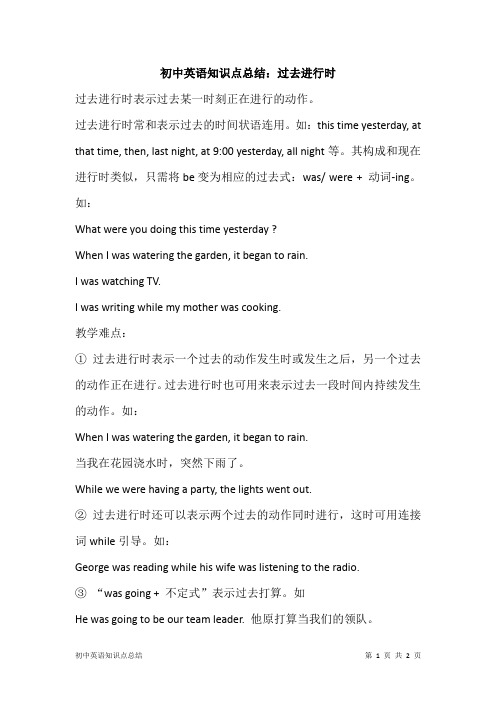
初中英语知识点总结:过去进行时过去进行时表示过去某一时刻正在进行的动作。
过去进行时常和表示过去的时间状语连用。
如:this time yesterday, at that time, then, last night, at 9:00 yesterday, all night等。
其构成和现在进行时类似,只需将be变为相应的过去式:was/ were + 动词-ing。
如:What were you doing this time yesterday ?When I was watering the garden, it began to rain.I was watching TV.I was writing while my mother was cooking.教学难点:①过去进行时表示一个过去的动作发生时或发生之后,另一个过去的动作正在进行。
过去进行时也可用来表示过去一段时间内持续发生的动作。
如:When I was watering the garden, it began to rain.当我在花园浇水时,突然下雨了。
While we were having a party, the lights went out.②过去进行时还可以表示两个过去的动作同时进行,这时可用连接词while引导。
如:George was reading while his wife was listening to the radio.③“was going + 不定式”表示过去打算。
如He was going to be our team leader. 他原打算当我们的领队。
④过去进行时与一般过去的区别过去进行时表示在过去一段时间正在进行的动作,而一般过去时表示一个完成的动作。
如:I was typing letters last night.I typed some letters last night.。
过去进行时知识点总结(word)

过去进行时知识点总结(word)一、过去进行时1.Jim ______ a late night film at home when, right in the middle of a thrilling scene, the television went blank.A. watchedB. was watchingC. had watchedD. would be watching【答案】 B【解析】【分析】句意:Jim正在家里看一场午夜电影这时就在刺激的一幕中间,电视机成了一片空白。
watched是过去式,观看;was watching过去进行时态;had watched过去完成时态;would be watching过去将来进行时。
根据句意可知,这里表示正在看电影的时候,电视机成了一片空白,表示过去正在发生的事情,故选B。
这里也是一个句型be doing sth. when...正在做某事,这时...。
2.I saw him in the library yesterday. He a book at that moment.A. readsB. is readingC. was readingD. will read【答案】 C【解析】【分析】at that moment 意为“在那时”,表示过去的时间点,表示过去某一时间正在进行的动作,用过去进行时,故选C。
句意是:我昨天在图书馆里看见他了,那时他正在看书。
【点评】本题考查过去进行时的用法。
3.Students in Grade Nine ____________a maths exam at this time yesterday.A. takeB. are takingC. were takingD. have taken【答案】 C【解析】【分析】句意:昨天的这个时候,九年级的学生正在参加数学考试。
根据at this time yesterday. 可知这是一个过去的具体的时刻,过去的具体时刻出现的句子应使用过去进行时,C是过去进行时,故答案是C。
过去进行时知识点讲解
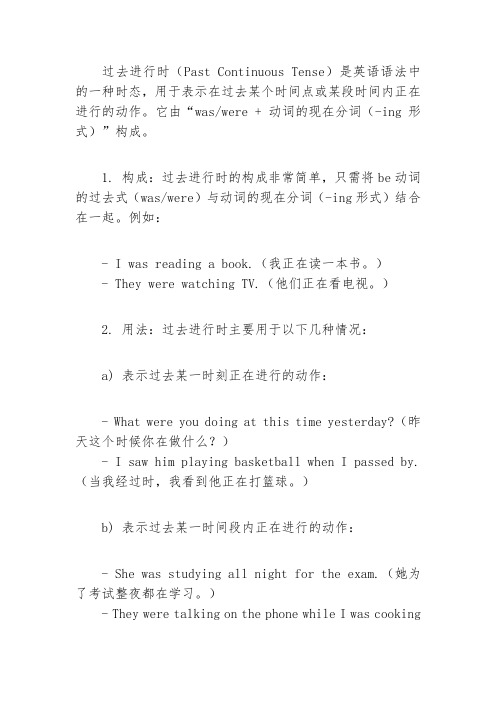
过去进行时(Past Continuous Tense)是英语语法中的一种时态,用于表示在过去某个时间点或某段时间内正在进行的动作。
它由“was/were + 动词的现在分词(-ing形式)”构成。
1. 构成:过去进行时的构成非常简单,只需将be动词的过去式(was/were)与动词的现在分词(-ing形式)结合在一起。
例如:- I was reading a book.(我正在读一本书。
)- They were watching TV.(他们正在看电视。
)2. 用法:过去进行时主要用于以下几种情况:a) 表示过去某一时刻正在进行的动作:- What were you doing at this time yesterday?(昨天这个时候你在做什么?)- I saw him playing basketball when I passed by.(当我经过时,我看到他正在打篮球。
)b) 表示过去某一时间段内正在进行的动作:- She was studying all night for the exam.(她为了考试整夜都在学习。
)- They were talking on the phone while I was cookingdinner.(我在做晚饭的时候,他们在打电话。
)c) 表示过去某一动作发生的背景或同时发生的另一个动作:- He was listening to music while he was working.(他在工作时听音乐。
)- She was reading a magazine when the phone rang.(电话响的时候,她正在看杂志。
)3. 注意事项:a) 当表示过去某一时刻正在进行的动作时,通常与表示过去的时间状语连用,如yesterday, last night, in 1990等。
b) 当表示过去某一时间段内正在进行的动作时,通常与表示过去的时间状语连用,如from 7 to 9 last night, all day yesterday等。
过去进行时知识点综合讲解及其习题专练(附答案)(完整版)

过去进行时知识点综合讲解及其习题专练(附答案)(完整版)一.过去进行时知识点:(一)定义:过去进行时表示过去某一时刻或某一段时间正在进行的动作;也表示过去某段时间一直存在的状态。
(二)形式:was / were + doing1. was:主语为单数(包括I)名词,代词,词组或是句子;was是am和is的过去式;2. were:主语为复数名词,代词,词组或是句子;were是are的过去式。
(三)常与表示过去的时间状语连用:1. this time yesterday/last week… 昨天或上个周……的这个时候;2. then那时;3. at that time在那个时候;4. at that moment在那个时刻;5. at 6 p.m. yesterday在昨天下午6:00;6. at the time of…在……的这个时候;7. when +过去时;8. while +过去进行时等。
e.g. I was watching TV when he called me up.They were building a bridge this time last year.They were expecting you yesterday.He was reading when the rainstorm came.While Mary was sleeping, Tom was doing his homework.(四)过去进行时中肯定句,否定句和一般疑问句的转换规则及一般疑问句的肯定及否定回答的知识点汇总。
含有be动词(was/were)的陈述句转换为一般疑问句时,直接把be动词提到句首,然后把“.”转换为“?”即可,其中第一人称I 和we要相应的转换为第二人称you。
肯定及否定回答用相对应的be 动词来回答即可,但是主语需转换为对应的人称代词(there be句型除外,直接用there来回答);若是肯定句转换为否定句,直接在be 动词后面加not,可缩写,可全称;但否定回答只能用缩写。
初二英语过去进行时知识点

初二英语过去进行时知识点过去进行时作为初中英语中最常见最重要的语法,在初二英语学习中占据重要的位置。
初二英语过去进行时的知识点有哪些呢?下面是店铺为大家带来的关于初二英语过去进行时的知识点,供大家参考。
初二英语知识点:过去进行时一. 定义过去进行时,是表示过去某个时刻或时间段正在进行的事情或动作。
二. 结构was/were +doing (现在分词)三. 用法1. 过去进行时表示过去某段时间内持续进行的动作或者事情。
常用的时间状语this morning, the whole morning, all day yesterday, from nine to ten last evening, when, while等。
例如:We were watching TV from seven to nine last night.昨天晚上七点到九点的时候我们在看电视。
What was he researching all day last Sunday?上周日他一整天都在研究什么?My brother fell and hurt himself while he was riding his bicycle.我哥哥骑自行车的时候从车上摔下来,受伤了。
It was raining when they left the station.他们离开车站的时候天正在下雨。
When I got to the top of the mountain, the sun was shining.当我到达山顶的时候,阳光灿烂。
2. 过去进行时可以表示在过去某个时间点发生的事情。
时间点可以用介词短语、副词或从句来表示。
例如:What was she doing at nine o'clock yesterday?昨天晚上九点她在做什么? (介词短语表示时间点)She was doing her homework then.那个时候她正在写作业。
初中英语知识点过去进行时

初中英语知识点过去进行时过去进行时是表示过去某一时刻正在进行的动作或状态,通常由was/were + 现在分词构成。
1. 构成肯定句:主语+ was/were + 现在分词+ 其他。
否定句:主语+ wasn't/weren't + 现在分词+ 其他。
疑问句:Was/Were + 主语+ 现在分词+ 其他?2. 用法(1)表示过去某一时刻正在进行的动作或状态。
例如:I was watching TV at 8 o'clock yesterday evening.昨天晚上8点钟我正在看电视。
(2)表示过去某一时刻正在进行的动作被打断了。
例如:I was studying when my friend called me.我正在学习,这时我的朋友给我打电话了。
(3)表示过去某一时刻正在进行的动作或状态与另一个同时发生的动作或状态相对比。
例如:While I was reading, my sister was watching TV.当我在读书的时候,我妹妹在看电视。
3. 注意事项(1)过去进行时强调的是过去某一时刻正在进行的动作或状态,与现在没有关系。
(2)过去进行时常与过去简单时连用,表示过去某一时刻正在进行的动作被打断了。
例如:I was watching TV when my mother came in.我正在看电视,这时我妈妈进来了。
(3)过去进行时常与表示时间的副词连用,如:at that time, at 8 o'clock, while等。
例如:At that time, I was playing basketball with my friends.那个时候,我正在和我的朋友们打篮球。
过去进行时知识点
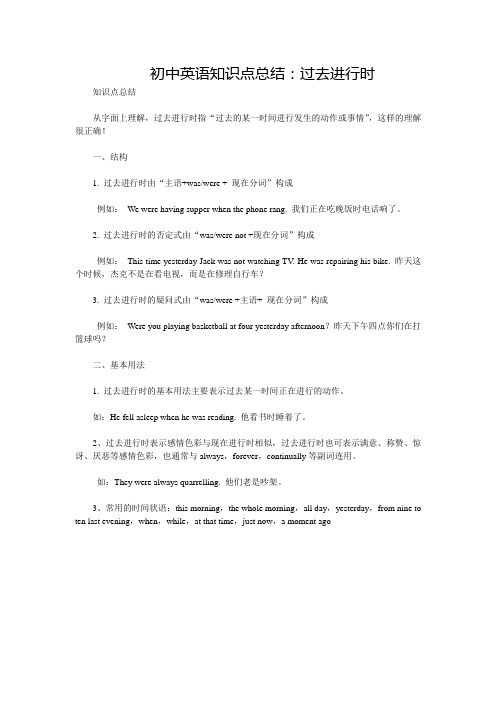
初中英语知识点总结:过去进行时知识点总结从字面上理解,过去进行时指“过去的某一时间进行发生的动作或事情”,这样的理解很正确!一、结构1. 过去进行时由“主语+was/were + 现在分词”构成例如:We were having supper when the phone rang. 我们正在吃晚饭时电话响了。
2. 过去进行时的否定式由“was/were not +现在分词”构成例如:This time yesterday Jack was not watching TV. He was repairing his bike. 昨天这个时候,杰克不是在看电视,而是在修理自行车?3. 过去进行时的疑问式由“was/were +主语+ 现在分词”构成例如:Were you playing basketball at four yesterday afternoon?昨天下午四点你们在打篮球吗?二、基本用法1. 过去进行时的基本用法主要表示过去某一时间正在进行的动作。
如:He fell asleep when he was reading. 他看书时睡着了。
2、过去进行时表示感情色彩与现在进行时相似,过去进行时也可表示满意、称赞、惊讶、厌恶等感情色彩,也通常与always,forever,continually等副词连用。
如:They were always quarrelling. 他们老是吵架。
3、常用的时间状语:this morning,the whole morning,all day,yesterday,from nine to ten last evening,when,while,at that time,just now,a moment ago。
过去进行时知识点总结
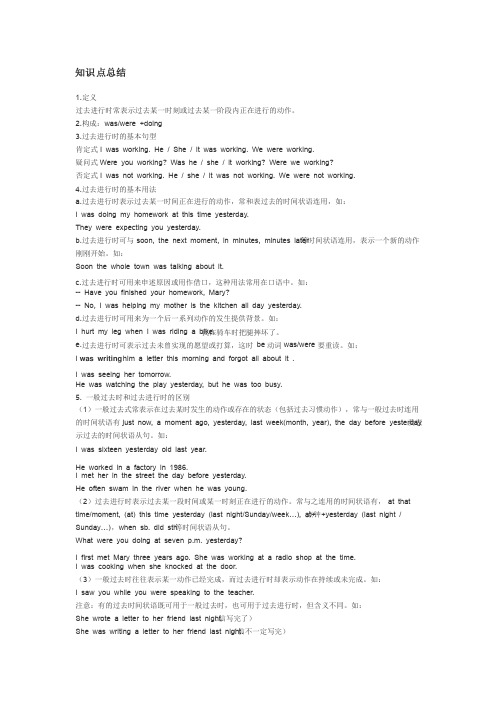
知识点总结1.定义过去进行时常表示过去某一时刻或过去某一阶段内正在进行的动作。
2.构成:was/were +doing3.过去进行时的基本句型 肯定式I was working. He / She / it was working. We were working.疑问式Were you working? Was he / she / it working? Were we working?否定式I was not working. He / she / it was not working. We were not working.4.过去进行时的基本用法a.过去进行时表示过去某一时间正在进行的动作,常和表过去的时间状语连用,如:I was doing my homework at this time yesterday. They were expecting you yesterday. b.过去进行时可与soon, the next moment, in minutes, minutes later等时间状语连用,表示一个新的动作刚刚开始。
如:Soon the whole town was talking about it. c.过去进行时可用来申述原因或用作借口,这种用法常用在口语中。
如:-- Have you finished your homework, Mary? -- No, I was helping my mother is the kitchen all day yesterday. d.过去进行时可用来为一个后一系列动作的发生提供背景。
如:I hurt my leg when I was riding a bike.我在骑车时把腿摔坏了。
e.过去进行时可表示过去未曾实现的愿望或打算,这时be动词was/were要重读。
如:I was writing him a letter this morning and forgot all about it . I was seeing her tomorrow. He was watching the play yesterday, but he was too busy. 5. 一般过去时和过去进行时的区别(1)一般过去式常表示在过去某时发生的动作或存在的状态(包括过去习惯动作),常与一般过去时连用及表的时间状语有just now, a moment ago, yesterday, last week(month, year), the day before yesterday 示过去的时间状语从句。
最新过去进行时知识点(大全)
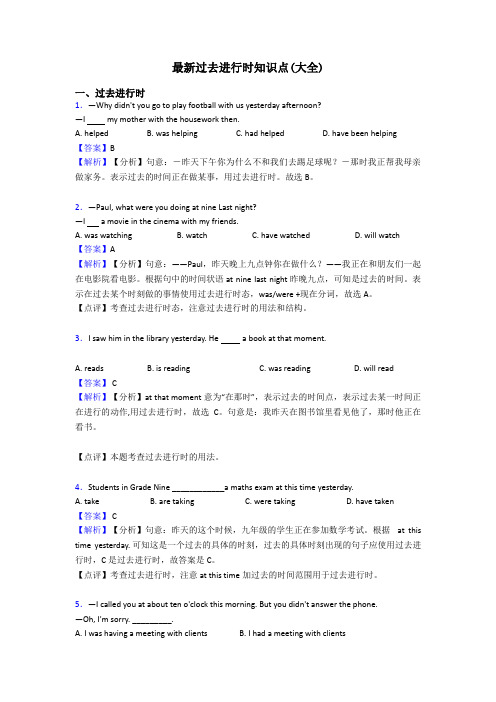
最新过去进行时知识点(大全)一、过去进行时1.—Why didn't you go to play football with us yesterday afternoon?—I my mother with the housework then.A. helpedB. was helpingC. had helpedD. have been helping【答案】B【解析】【分析】句意:-昨天下午你为什么不和我们去踢足球呢?-那时我正帮我母亲做家务。
表示过去的时间正在做某事,用过去进行时。
故选B。
2.—Paul, what were you doing at nine Last night?—I a movie in the cinema with my friends.A. was watchingB. watchC. have watchedD. will watch【答案】A【解析】【分析】句意:——Paul,昨天晚上九点钟你在做什么?——我正在和朋友们一起在电影院看电影。
根据句中的时间状语at nine last night昨晚九点,可知是过去的时间。
表示在过去某个时刻做的事情使用过去进行时态,was/were +现在分词,故选A。
【点评】考查过去进行时态,注意过去进行时的用法和结构。
3.I saw him in the library yesterday. He a book at that moment.A. readsB. is readingC. was readingD. will read【答案】 C【解析】【分析】at that moment 意为“在那时”,表示过去的时间点,表示过去某一时间正在进行的动作,用过去进行时,故选C。
句意是:我昨天在图书馆里看见他了,那时他正在看书。
【点评】本题考查过去进行时的用法。
4.Students in Grade Nine ____________a maths exam at this time yesterday.A. takeB. are takingC. were takingD. have taken【答案】 C【解析】【分析】句意:昨天的这个时候,九年级的学生正在参加数学考试。
过去进行时知识点及练习
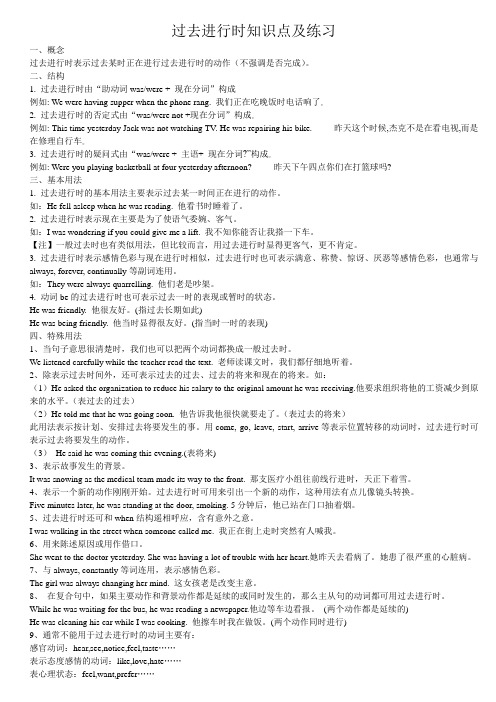
过去进行时知识点及练习一、概念过去进行时表示过去某时正在进行过去进行时的动作(不强调是否完成)。
二、结构1. 过去进行时由“助动词was/were + 现在分词”构成例如: We were having supper when the phone rang. 我们正在吃晚饭时电话响了。2. 过去进行时的否定式由“was/were not +现在分词”构成。例如: This time yesterday Jack was not watching TV. He was repairing his bike. 昨天这个时候,杰克不是在看电视,而是在修理自行车。3. 过去进行时的疑问式由“was/were + 主语+ 现在分词?”构成。例如: Were you playing basketball at four yesterday afternoon? 昨天下午四点你们在打篮球吗?三、基本用法1. 过去进行时的基本用法主要表示过去某一时间正在进行的动作。
如:He fell asleep when he was reading. 他看书时睡着了。
2. 过去进行时表示现在主要是为了使语气委婉、客气。
如:I was wondering if you could give me a lift. 我不知你能否让我搭一下车。
【注】一般过去时也有类似用法,但比较而言,用过去进行时显得更客气,更不肯定。
3. 过去进行时表示感情色彩与现在进行时相似,过去进行时也可表示满意、称赞、惊讶、厌恶等感情色彩,也通常与always, forever, continually等副词连用。
如:They were always quarrelling. 他们老是吵架。
4. 动词be的过去进行时也可表示过去一时的表现或暂时的状态。
He was friendly. 他很友好。
(指过去长期如此)He was being friendly. 他当时显得很友好。
过去进行时知识点详解(初中英语专项复习) (3)

过去进行时知识点详解(初中英语专项复习)过去进行时主要表示过去某一时刻正在进行的动作,或表示过去某一阶段一直在进行的动作。
1. 构成:助动词was (were) + 动词的现在分词。
如:I was having a talk with Zhang Hong at this time yesterday. 昨天这个时候我正在跟张红谈话。
They were watching TV at home last night. 昨晚他们一直在看电视。
2. 基本句型:3. 基本用法:(1)过去进行时表示过去某一时间正在进行的动作,常和表过去的时间点的状语连用,如:I was doing my homework at eight yesterday evening. 昨天晚上八点钟我正在做作业。
Was she watching TV at home at ten o’clock last night? 昨天晚上十点钟她正在家里看电视吗?(2)过去进行时的主要用法是描述一件事发生的背景;一个长动作发生的时候,另一个短动作发生。
常用的时间状语有:this morning, the whole morning, all day yesterday, from nine to ten last evening, when, while等。
如:We were watching TV from seven to nine last night. 昨天晚上七点到九点的时候我们在看电视。
What was he doing all day last Sunday? 上周日他一整天都在做什么?My brother fell while he was riding his bicycle and hurt himself. 我哥哥骑自行车的时候从车上摔下来,受伤了。
It was snowing when they left the station. 他们离开车站的时候天正在下雪。
复习专题过去进行时知识点归纳

复习专题过去进行时知识点归纳一、过去进行时my desk ・mate with her lessons when I left school.・ 1 ■•一She is really a nice teacher. A. helps C ・ was helpingC 【答案】【解析】【分析】句意:一当我离开学校时,林老师在帮我的同桌学习功课。
一 她真是•位好老师。
当我离开时,老师正在帮学习,•个过去动作“离开”发生时,另•个过去 动作。
正在发生。
故用过去进行时态,选C “帮助”Amon _____________ his ship in a big storm when a giant fish came out of the sea ・2・ A. will sail B ・ is sailing C ・ was sailingD. has sailed C 【答案】【解析】【分析】句意:当•条人鱼从海中跳出来时,阿蒙正驾船在 大暴雨中航行。
根据when a giant fish came out of the sea»可知当鱼跳岀来时阿蒙正在驾船航彳亍。
when 引导时间状 语从句,衣示在过去,当从句的动作发生时,主句的动作在当时也正在进行。
主句的 。
时 态是过去进行时,故选C 引导时间状语从句,注意主句的时态。
when 【点评】此题考查过去进 行时。
Oh! Whafs wrong with your finger? —3・I hurt it while I ____________ a model plane.—— A ・ madeB ・ was makingC ・ am making D. make B 【答案】【解析】【分析】句意:一一哦!你的手指怎么啦? 一一我在制作飞机模型时受 伤了。
while 引导的状语从句是进行时,此处指在过去制作飞机模型时受伤,句了时态用过去进 行B 。
最新过去进行时知识点总结
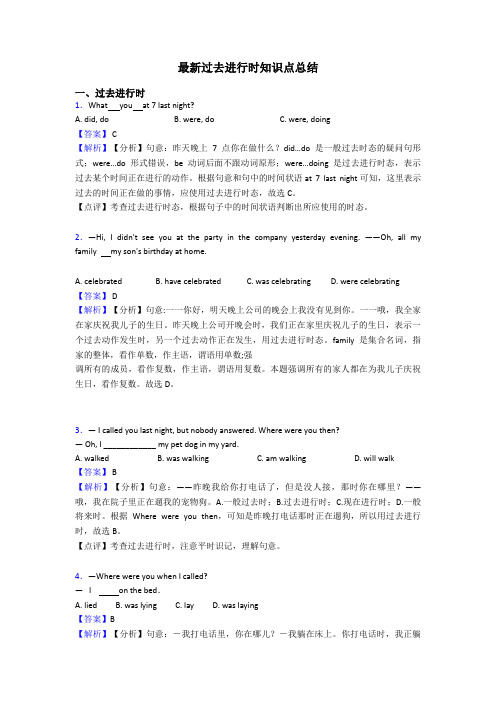
最新过去进行时知识点总结一、过去进行时1.What you at 7 last night?A. did, doB. were, doC. were, doing【答案】 C【解析】【分析】句意:昨天晚上7点你在做什么?did…do是一般过去时态的疑问句形式;were…do形式错误,be动词后面不跟动词原形;were…doing是过去进行时态,表示过去某个时间正在进行的动作。
根据句意和句中的时间状语at 7 last night可知,这里表示过去的时间正在做的事情,应使用过去进行时态,故选C。
【点评】考查过去进行时态,根据句子中的时间状语判断出所应使用的时态。
2.—Hi, I didn't see you at the party in the company yesterday evening. ——Oh, all my family my son's birthday at home.A. celebratedB. have celebratedC. was celebratingD. were celebrating【答案】 D【解析】【分析】句意:一一你好,明天晚上公司的晚会上我没有见到你。
一一哦,我全家在家庆祝我儿子的生日。
昨天晚上公司开晚会时,我们正在家里庆祝儿子的生日,表示一个过去动作发生时,另一个过去动作正在发生,用过去进行时态。
family是集合名词,指家的整体,看作单数,作主语,谓语用单数;强调所有的成员,看作复数,作主语,谓语用复数。
本题强调所有的家人都在为我儿子庆祝生日,看作复数。
故选D。
3.— I called you last night, but nobody answered. Where were you then?— Oh, I ____________ my pet dog in my yard.A. walkedB. was walkingC. am walkingD. will walk【答案】 B【解析】【分析】句意:——昨晚我给你打电话了,但是没人接,那时你在哪里?——哦,我在院子里正在遛我的宠物狗。
八年级过去进行时 知识点
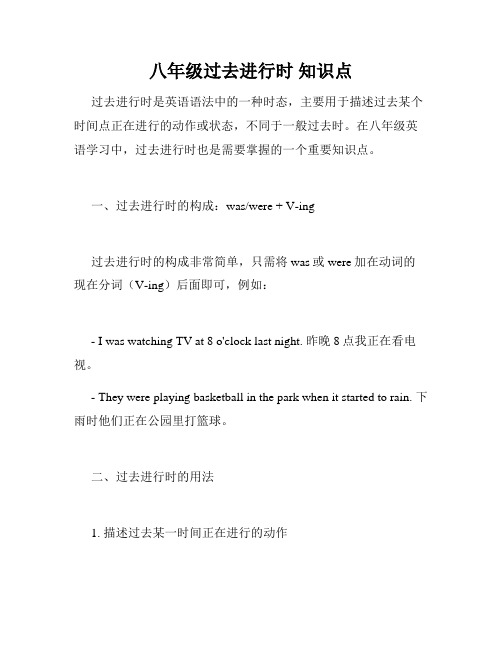
八年级过去进行时知识点过去进行时是英语语法中的一种时态,主要用于描述过去某个时间点正在进行的动作或状态,不同于一般过去时。
在八年级英语学习中,过去进行时也是需要掌握的一个重要知识点。
一、过去进行时的构成:was/were + V-ing过去进行时的构成非常简单,只需将was或were加在动词的现在分词(V-ing)后面即可,例如:- I was watching TV at 8 o'clock last night. 昨晚8点我正在看电视。
- They were playing basketball in the park when it started to rain. 下雨时他们正在公园里打篮球。
二、过去进行时的用法1. 描述过去某一时间正在进行的动作The phone rang while I was having dinner.当我正在吃晚饭时电话响了。
2. 用于加强动作的持续性He was studying for three hours without a break.他连续三个小时都在学习。
3. 描述过去同时发生的两个动作While John was driving to work, he had an accident.约翰在开车上班的路上发生了车祸。
4. 描述过去进行的状态I was feeling tired and hungry after playing basketball all morning.我打了一个上午的篮球后感到又累又饿。
5. 用于表示委婉语气I was just wondering if you could help me with my math homework.我不知道你是否能帮我做数学作业。
三、过去进行时的时间状语表示过去进行时的时间状语有很多种,例如:- at this time yesterday 在昨天这个时间- at 5 o'clock last night 昨晚5点钟- while I was doing my homework 我做作业的时候- at that moment 那个时刻总之,过去进行时是英语语法中非常基础的一个时态,掌握其构成和用法对于八年级的英语学习具有很大的帮助。
初中英语过去进行时的知识点

初中英语过去进行时的知识点初中英语过去进行时的知识点定义:是指过去某个时间正在进行的动作,或者是指过去某个阶段一直在进行的动作。
例如:当时我正在和李华谈话。
当时,我正在和李华说话。
昨晚我在家看电视。
昨晚我一直在看电视。
结构:由“过去/现在分词”组成。
例如:那时我正在做功课。
那时我正在做作业。
我们在打扫房子。
我们正在打扫房子。
1.时间点可以用介词短语、副词或从句来表示。
她昨天九点钟在做什么?昨晚九点她在做什么?(介词短语表示时间点)当我看到他时,他正在装饰他的房间。
当我看到他的房间时,他正在装修。
(when子句表示时间点)2.在复合句中,如果主动作和背景动作都是连续或同时的,那么主句中的动词可以用过去进行时。
当他等公共汽车时,他正在看报纸。
他在等车的时候看了报纸。
(两个动作都是连续的)我做饭的时候,他正在清洗他的车。
他洗车的时候我正在做饭。
(同时执行两个动作)一般不能用过去进行时的动词主要有:同意、是、相信、属于、关心、忘记、讨厌、有(有)、听到、知道、喜欢、爱、意思、介意、注意、拥有、记得、似乎、支持、理解、想要、愿望等。
3.使用过去进行时应注意的几点(1)过去进行时可以表示过去某个时间按计划和安排将要发生的动作。
例如:他说他们今天下午要去北京。
他说他今天下午要去北京。
希望、惊奇等动词的过去进行时。
常用来表达请求。
虽然表达的是现在的内容,但语气比一般现在时或一般过去时更委婉。
例如:我想知道你是否能来加入我们。
我想知道你是否能来加入我们?当过去进行时被总是、永远、持续、不断修饰时,表示说话人的欣赏或厌烦之情。
例如:他总是想着别人。
他总是为别人着想。
过去进行时知识点总结
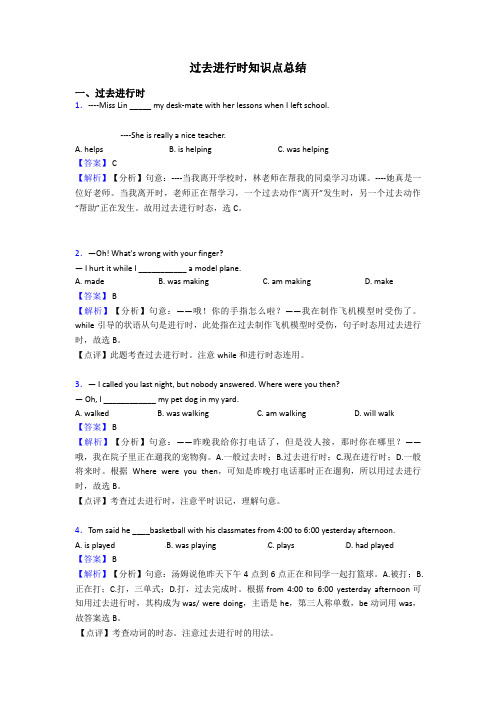
过去进行时知识点总结一、过去进行时1.----Miss Lin _____ my desk-mate with her lessons when I left school.----She is really a nice teacher.A. helpsB. is helpingC. was helping【答案】 C【解析】【分析】句意:----当我离开学校时,林老师在帮我的同桌学习功课。
----她真是一位好老师。
当我离开时,老师正在帮学习,一个过去动作“离开”发生时,另一个过去动作“帮助”正在发生。
故用过去进行时态,选C。
2.—Oh! What's wrong with your finger?— I hurt it while I ___________ a model plane.A. madeB. was makingC. am makingD. make【答案】 B【解析】【分析】句意:——哦!你的手指怎么啦?——我在制作飞机模型时受伤了。
while引导的状语从句是进行时,此处指在过去制作飞机模型时受伤,句子时态用过去进行时,故选B。
【点评】此题考查过去进行时。
注意while和进行时态连用。
3.— I called you last night, but nobody answered. Where were you then?— Oh, I ____________ my pet dog in my yard.A. walkedB. was walkingC. am walkingD. will walk【答案】 B【解析】【分析】句意:——昨晚我给你打电话了,但是没人接,那时你在哪里?——哦,我在院子里正在遛我的宠物狗。
A.一般过去时;B.过去进行时;C.现在进行时;D.一般将来时。
根据Where were you then,可知是昨晚打电话那时正在遛狗,所以用过去进行时,故选B。
- 1、下载文档前请自行甄别文档内容的完整性,平台不提供额外的编辑、内容补充、找答案等附加服务。
- 2、"仅部分预览"的文档,不可在线预览部分如存在完整性等问题,可反馈申请退款(可完整预览的文档不适用该条件!)。
- 3、如文档侵犯您的权益,请联系客服反馈,我们会尽快为您处理(人工客服工作时间:9:00-18:30)。
南阳镇平涅阳二初中
申红娟
• 一、概念 过去进行时表示过去某时正在进行过去进行时的动作(不 强调是否完成)。 二、结构 1. 过去进行时由“助动词was/were + 现在分词”构成 例如: We were having supper when the phone rang. 我们 正在吃晚饭时电话响了。 2. 过去进行时的否定式由“was/were not +现在分词”构 成。 例如: This time yesterday Jack was not watching TV. He was repairing his bike. 昨天这个时候,杰克不是在看电 视,而是在修理自行车。 3. 过去进行时的疑问式由“was/were + 主语+ 现在分词?” 构成。 例如: Were you playing basketball at four yesterday afternoon? 昨天下午四点你们在打篮球吗?
ห้องสมุดไป่ตู้
• when 和while的用法区别 1、when是at or during the time that, 既指时间点,也可 指一段时间; while是during the time that,只指一段时间, 因此when引导的时间状语从句中的动词可以是终止性动 词,也可以是延续性动词,而while从句中的动词必须是 延续性动词。 2、when 说明从句的动作和主句的动作可以是同时,也可 以是先后发生;while 则强调主句的动作在从句动作的发 生的过程中或主从句两个动作同时发生。 3、由when引导的时间状语从句,主句用过去进行时,从 句应用一般过去时;如果从句和主句的动作同时发生,两 句都用过去进行时的时候,多用while引导,如: When the teacher came in, we were talking. 当此句改变主从句的位置时,则为: While we were talking, the teacher came in. They were singing while we were dancing
• 四、特殊用法 1、当句子意思很清楚时,我们也可以把两个动词都换成一般过去时。 We listened carefully while the teacher read the text. 老师读课文时, 我们都仔细地听着。 2、除表示过去时间外,还可表示过去的过去、过去的将来和现在的 将来。如: (1)He asked the organization to reduce his salary to the original amount he was receiving.他要求组织将他的工资减少到原来的水平。 (表过去的过去) (2)He told me that he was going soon. 他告诉我他很快就要走了。 (表过去的将来) 此用法表示按计划、安排过去将要发生的事。用come, go, leave, start, arrive等表示位置转移的动词时,过去进行时可表示过去将要发 生的动作。 (3) He said he was coming this evening.(表将来) 3、表示故事发生的背景。 It was snowing as the medical team made its way to the front. 那支 医疗小组往前线行进时,天正下着雪。 4、表示一个新的动作刚刚开始。过去进行时可用来引出一个新的动 作,这种用法有点儿像镜头转换。 Five minutes later, he was standing at the door, smoking. 5分钟后, 他已站在门口抽
• 三、基本用法 1. 过去进行时的基本用法主要表示过去某一时间正在进行 的动作。 如:He fell asleep when he was reading. 他看书时睡着 了。 2. 过去进行时表示现在主要是为了使语气委婉、客气。 如:I was wondering if you could give me a lift. 我不知你 能否让我搭一下车。 【注】一般过去时也有类似用法,但比较而言,用过去进 行时显得更客气,更不肯定。 3. 过去进行时表示感情色彩与现在进行时相似,过去进行 时也可表示满意、称赞、惊讶、厌恶等感情色彩,也通常 与 always, forever, continually等副词连用。 如:They were always quarrelling. 他们老是吵架。 4. 动词be的过去进行时也可表示过去一时的表现或暂时的 状态。 He was friendly. 他很友好。(指过去长期如此) He was being friendly. 他当时显得很友好。(指当时一时 的表现)
• 5、过去进行时还可和when结构遥相呼应,含有意外之意。 I was walking in the street when someone called me. 我 正在街上走时突然有人喊我。 6、用来陈述原因或用作借口。 She went to the doctor yesterday. She was having a lot of trouble with her heart.她昨天去看病了。她患了很严重 的心脏病。 7、与always, constantly等词连用,表示感情色彩。 The girl was always changing her mind. 这女孩老是改变 主意。 8、 在复合句中,如果主要动作和背景动作都是延续的或 同时发生的,那么主从句的动词都可用过去进行时。 While he was waiting for the bus, he was reading a newspaper.他边等车边看报。 (两个动作都是延续的) He was cleaning his car while I was cooking. 他擦车时我 在做饭。(两个动作同时进行)
• 9、通常不能用于过去进行时的动词主要有: 感官动词:hear,see,notice,feel,taste…… 表示态度感情的动词:like,love,hate…… 表心理状态:feel,want,prefer…… 表占有:own,have,…… 表存在状态和持续:look,owe,be…… 例如: I was knowing the answer. I knew the answer. 我知道答案。 I wasn‘t understanding him. I didn‘t understand him. 我不明白他的意思。
